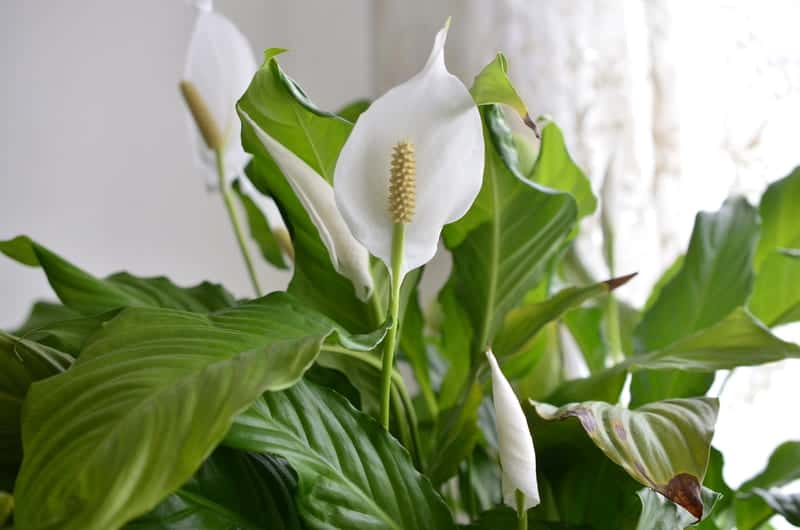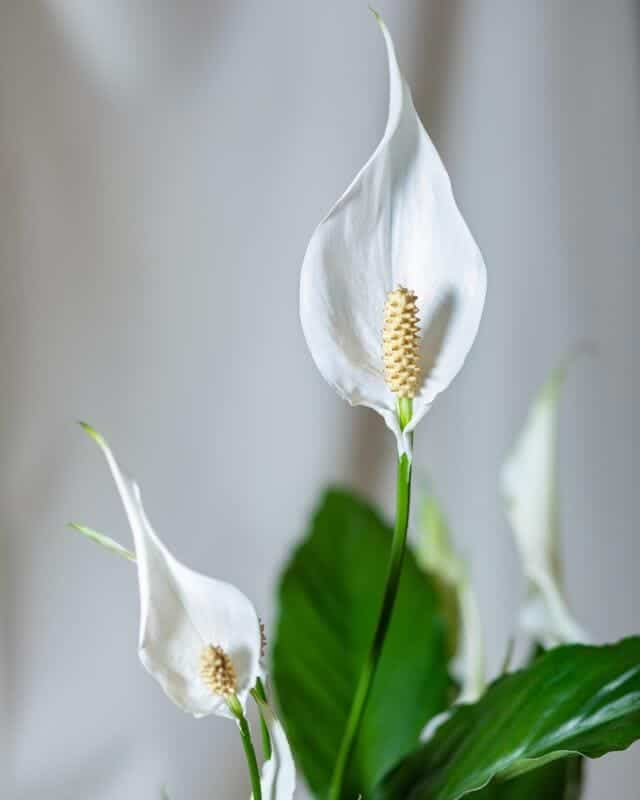Peace lilies, originally a tropical plant found of forest floors, now make an elegant addition to the plant family in modern homes all across the world. For this reason, it can be worrying to see its slender white flower has begun turning brown or spotting blackening tips.
In this article we will explore all the possible causes, get to the root of the problem and tackle the cure head-on.
Why do Peace Lily Flowers turn brown?
The causes for peace lily flowers turning brown can include over-watering, underwatering, exposure to extreme temperatures, insufficient light, and natural aging. Over-watering can lead to root rot, while underwatering can cause the flower to wilt and turn brown.
Each and every flower has its own natural cycle and the peace lily is no exception, with peace lily flowers having a lifespan that can last between 10 days to a month.
In most cases, if your plant is otherwise healthy, the flower of your peace lily turning brown is due to the end of its cycle.

Having said that, if you notice your flower turning brown or black prematurely, it’s essential to get to the bottom of it in order to keep your plant healthy and blooming the next time around. After all, every houseplant has its own unique mixture of requirements to stay healthy which will then contribute to its overall longevity.
Causes for browning or blackening peace lily flowers are:
- Moving your plant to a different location in your home can drastically affect its health as it might bring with a warm or cool draft, affecting the plants ideal environment.
- Over or underwatering the soil can cause the browning of tips.
- Poor soil mix varieties retain water, and whilst beneficial for some plants, can cause illness in peace lilies that cause brown tips on the flower and leaves. The soil being tightly compact will have the same result as it makes it difficult for the roots to breathe.
- Lack of proper drainage is one of the most common reasons. Adequate drainage is vital for any potted plant.
- Tap water in most areas has high amounts of fluoride and chlorine in it which are harmful to your peace lily and can result in brown or blackened blooms and leaves
- Fungus and rot thrive in overly moist conditions, such as damp peace lily leaves and flowers for an extended time.
Should you cut off brown Peace Lily flowers?
While general pruning, trimming and removing old and wilting flowers and leaves from any plant keeps it tidy and is recommended as it helps encourage growth, it is especially important to do so with browning peace lilies.
Whether you know the cause of the brown (or blackened) spots on your peace lily or not, it is always wise to cut them off to keep the cause from spreading and infecting the rest of the plant, or even neighbouring plants too.
Besides, dead or dying plant leaves no longer bring nourishment to the plant, and so removing them makes logical sense to do.
How to Remove Browning Peace Lily Flowers?
To remove a browning or dead peace lily, cut at the base of your peace lily flower head, slicing the stems. If you notice even slight leaf discoloration, such as browning, yellowing, or blackening, cut these off too.
It’s important to use a clean pair of clean kitchen scissors or pruning shears to remove the dead stems and flowers to avoid unnecessary stress and damage to your plant.
Removing old foliage, even if not browning, helps keep the plant from diverting the plants nutrients, and instead focuses its energy to new growth and future blooming.
Cures for Browning or Blackening Peace Lily Flowers
Peace Lilies are relatively easy plants to look after, which is why they often make the perfect gifts or office plant, although even a slight change in care can result in your plant not blooming, dying prematurely, or developing an illness.
Especially if you have multiple indoor plants, remembering their individual care needs can be tricky.
If your peace lily is indoors, it’s unlikely that the browning or blackening is caused by pests. This leaves the likely cause being improper care.
Improper care can either directly be the cause of the browning or a side effect of the plant becoming stressed, making it divert its energy away from the flowers to preserve foliage.
Luckily, while there may be quite a few reasons why your lily may be prematurely browning, following a simple care plan, once you have removed the infected or browning flowers, is usually all that’s needed to get them back into tip top shape.
In doing so, you will eradicate any current issues and prevent them from happening again.
Weekly care guide for Peace Lily
Watering is essential to be done in the early morning and only once the potting mix is one-third dried out. You can check this but sticking your index finger into the potting mix.
If you feel the soil damp one knuckle-deep, then it’s best to check back in a couple of days. This rule of thumb ensures that you do not over-water your peace lily and that any beads of water on the leaves will evaporate as the morning goes on.
If you live in an area with hard tap water, ensure you are using distilled water to quench your peace lily.
Adequate drainage is vital to prevent fungus and mold that thrives in areas of stagnant water. Ensuring the underside of your pot has plenty of holes in which excess water can drain out of the pot. Removing the excess water that sits in the outer dish or ceramic pot is also important.
The amount of light that your peace lily is exposed to greatly impact its health. It should be in a room with bright natural light but never in direct sunlight, even if sheltered through a window.
Air circulation is a must. This means that the best place for your peace lily is in the centre of room, as opposed to a stuffy corner.
At the same time, it is essential that it is positioned away from drafts (including air conditioning and heating appliances), whether warm or cool, as they will mess the climate of the area and stress your lily out.
Humidity is your peace lily’s best friend. Having originated from growing on forest floors, mimicking that environment as much as possible is always a good bet.
Most of the climates in our homes provide a sufficient amount of humidity, though if you live in a particularly dry area, try leaving a tray of pebbles and water near your peace lily or spritz it daily to encourage humidity.
Related: Rosemary Turning Brown: 7 Causes & Cure
Annual care guid is as follows:
Feed your peace lily twice a year. The first time at the start of spring and then again as summer nears.
This should be done with a diluted amount of plant feed, adding enough distilled water until it is a weak mixture, further than the amount listed in the instructions of your brand of choice.
You should never feed your peace lily in the autumn or winter months as this is the time that your plant is dormant. Over-feeding your plants will result in browning and blackened leaves and flowers due to the mineral build-up.
Repotting your peace lily should also be done in the early spring months to give your plant ample time to settle into its new pot and flower.
The Royal Horticultural Society (RHS) recommends annually repotting your peace lily if the roots have filled out the pot.
Repotting more than once a year is not recommended and could stress out your plant, damaging its flower production and health.
Replacing soil with well-draining compost that is mixed with sand and perlite will also help to maintain a well-watered happy peace lily as it keeps the soil light and airy.
A handy tip to remember is that if water runs through the drainage holes as soon as you water the plant, it means that your plant is pot-bound and needs to be repotted.
Trimming is necessary at some stage for all plants, but is particularly important for delicate ones, such as the peace lily.
Alongside trimming any browning flowers and foliage, it always best to do a routine trim at the end of the of the flowering season – in autumn.
This includes trimming off older outer and low-hanging leaves to ensure that the plant can focus its energy on regenerating blooms for the next spring, whilst also keeping its appearance fresh and compact.
How do I know if my Peace Lily is dying?
The average life span for a peace lily plant is between three and five years.
If you’ve had your lily for less time than this, chances are your plant is not dying, yet in fact just needs a little more care and attention.
It’s also important to note that if the flower on your peace lily dies, that does not mean your entire peace lily plant is dead or dying.
Each bloom only lasts between ten to twenty-one days before beginning to fade, so don’t get ahead of yourself and discard the entire plant right away.
Healthy lily plants do not produce new flowers for several months in a year. This period of dormancy through autumn till late early spring, after the plant is done producing flowers from spring to summer.
It is perfectly natural for your old flowers, along with old leaves, to turn brown and die on an otherwise healthy plant.
Having said that, all beautiful things will come to an inevitable end. The signs of a dying peace lily are identical to that of an uncared-for lily.
Therefore, unfortunately, there is no way to know for sure whether your lily is simply a little under the weather or has come to the end of its life.
If you follow the above care-guide for several months and your lily is still not in its full strength, then that could be a telling sign that your plant is dying.
Tip: Be sure not to make any drastic changes to care routine or environment once your peace lily begins to flower if you want to enjoy your blooms for as long as possible. Something as simple as moving it from one spot to another can make a world of difference for your plant.
Overall, the Peace lily is a distinctly poised plant that produces show-stopping white flowers that will reward you with bountiful blooms in the spring and summer months if cared for properly.
They require very little hands-on care, with only intermittent watering to be happy and are a symbol of prosperity, hope, healing, and of course, peace. The perfect embellishment to any room in your home.


